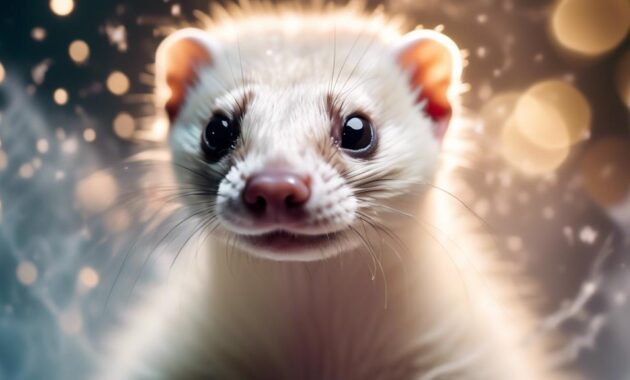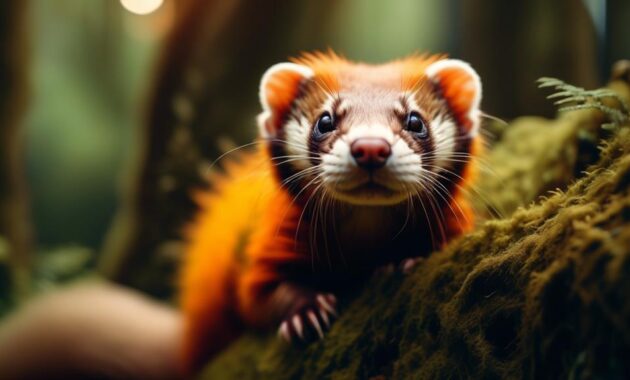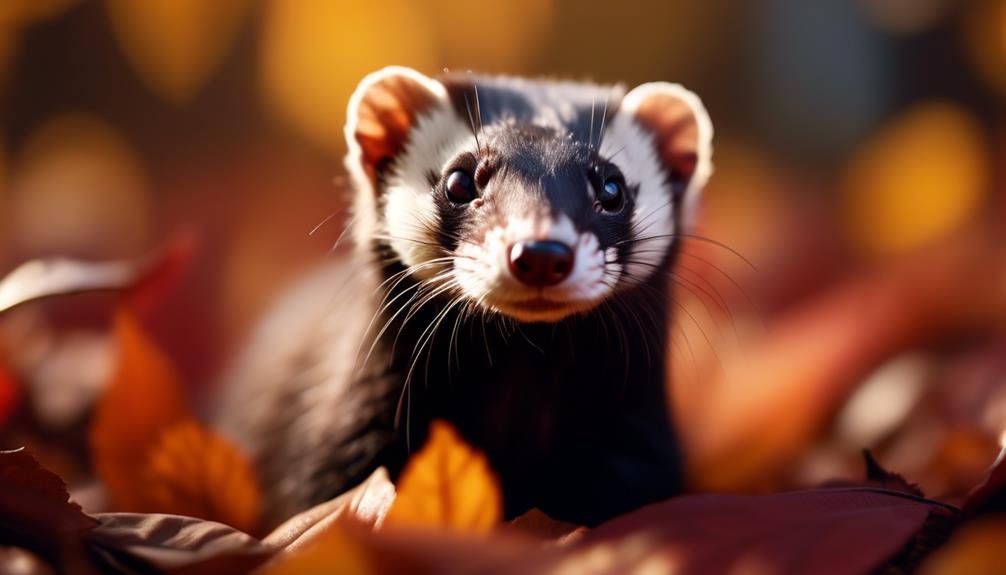
In the realm of captivating creatures, the sable ferret holds a mysterious allure, revealing its secrets only to those who are willing to delve into its enigmatic world.
From the depths of its scientific origins to its fascinating history as a hunter’s companion, the sable ferret has left an indelible mark on human society.
With its distinctive appearance and playful demeanor, this creature has captured the hearts of ferret enthusiasts around the globe.
But what lies beyond its charming facade? What are the sizzling secrets that make the sable ferret truly extraordinary?
Join us on this exploration as we peel back the layers of mystery and reveal the hidden depths of these captivating creatures.
Key Takeaways
- Sable ferrets were originally domesticated to hunt rabbits and vermin, and they are descendants of European polecats.
- Sable ferrets have different color morphs, including mask sable ferrets and mitt sable ferrets, and they have a distinctive dark mask on their faces.
- Sable ferrets are inquisitive, playful, and can be trained to do tricks and use a litter box.
- Pet sable ferrets need a large enclosure with a metal cage and a diet specifically made for them, containing a healthy amount of taurine. They are also prone to various health issues, so regular check-ups are important.
Sable Ferret Facts
Sable ferrets, descendants of European polecats, are fascinating creatures with a rich history of domestication and a unique set of characteristics and behaviors. A male ferret is called a hob, a female a jill, and a baby a kit.
These ferrets were originally domesticated to hunt rabbits and vermin. They are obligate carnivores and cannot be fed a vegetarian diet. It is important to introduce a baby sable ferret to a variety of food items, imprinting on its food at around six months old.
The scientific name of the sable ferret is Mustela furo, with Mustela meaning weasel and furo meaning cat or robber in Latin. Sable ferrets have been popular pets for over 2,000 years and have gained popularity as lovable companions in the 20th century.
Scientific Information
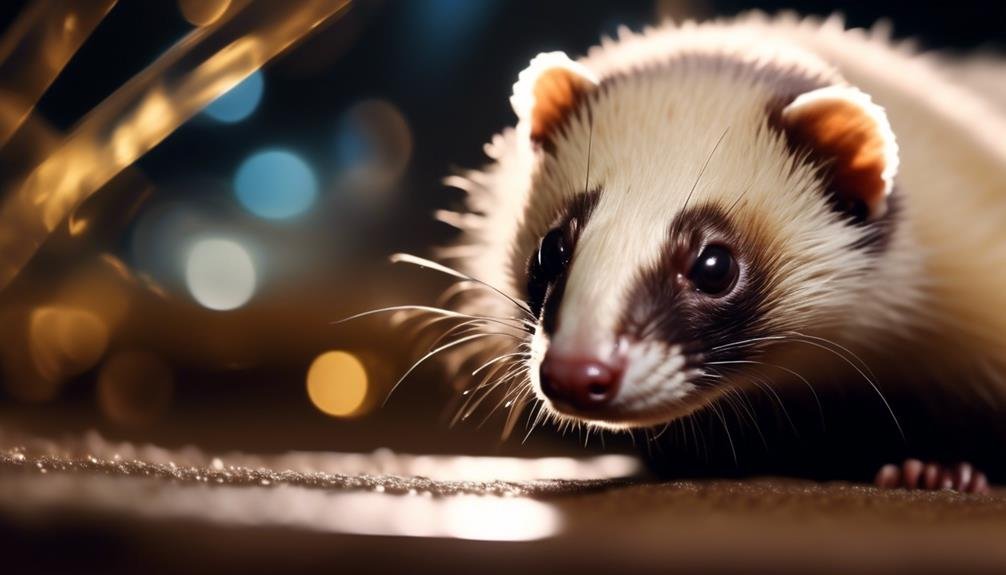
The sable ferret, scientifically known as Mustela furo, is a fascinating creature with a rich history of domestication and unique characteristics and behaviors. Here are some scientific facts about these intriguing animals:
- Scientific Name: The sable ferret’s scientific name is Mustela furo. The term ‘Mustela’ comes from Latin and means weasel, while ‘furo’ translates to cat or robber. It is also known by the synonym Mustela putorius furo.
- Ancestor: The sable ferret is believed to have descended from the European polecat (Mustela putorius). These ferrets were originally domesticated to assist in hunting rabbits and controlling vermin populations.
- Domestication History: Sable ferrets may have been domesticated over 2,000 years ago. They were highly valued by the Greeks and Romans for their hunting abilities and their contribution to rodent control. In the 20th century, sable ferrets gained popularity as beloved pets, becoming one of the most sought-after color variations among ferret enthusiasts.
The scientific information about sable ferrets sheds light on their origins, classification, and historical significance, further highlighting their captivating nature.
History of Sable Ferrets
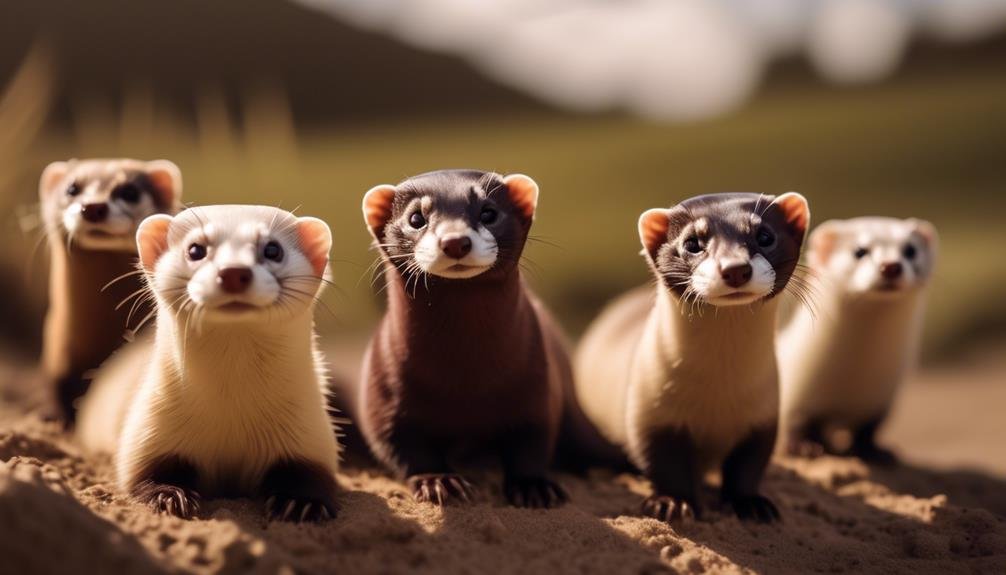
Having explored the scientific information surrounding sable ferrets, it is now imperative to delve into their intriguing history and the significant role they have played throughout the ages. Sable ferrets are descendants of European polecats (Mustela putorius) and may have been domesticated over 2,000 years ago. They gained popularity as lovable pets in the 20th century and became one of the most popular color variations among ferret enthusiasts. However, their history goes beyond being pets. Ferrets have aided Greeks and Romans with hunting and controlling rodent populations. To highlight their historical significance, here is a table showcasing the key moments in the history of sable ferrets:
| Time Period | Role of Sable Ferrets |
|---|---|
| Over 2,000 years ago | Domesticated and used for hunting and vermin control |
| Greek and Roman times | Assisted with hunting and rodent population control |
| 20th century | Gained popularity as lovable pets |
| Present day | Among the most popular color variations of ferrets |
Understanding the history of sable ferrets provides valuable insight into their enduring relationship with humans and their multifaceted contributions throughout the ages.
Appearance and Behavior
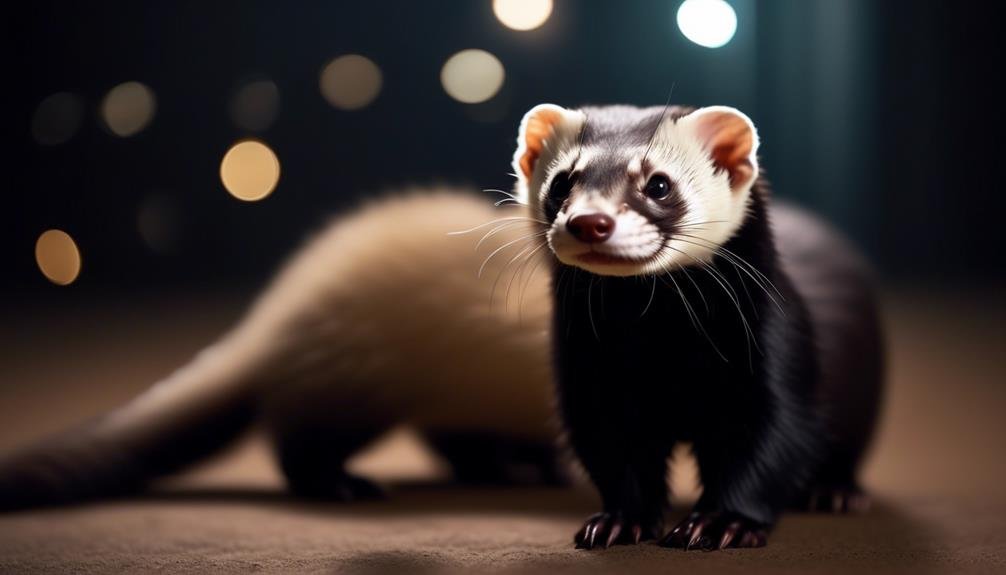
The physical characteristics and behavioral traits of sable ferrets make them a fascinating species to study and observe. Here are three interesting facts about their appearance and behavior:
- Color Morphs: Sable ferrets come in different color variations, including mask sable ferrets and mitt sable ferrets. These variations contribute to their unique and attractive appearance.
- Distinctive Features: Sable ferrets have long, limber bodies and a distinctive dark mask on their faces. These features add to their charm and make them easily recognizable.
- Playful and Vocal: Sable ferrets are known for their inquisitive and playful nature. They spend a significant amount of time playing and exploring their environment. Additionally, they communicate through a variety of sounds, including docks, clucks, screeches, squeaks, barks, and hisses.
Studying the appearance and behavior of sable ferrets provides insights into their captivating characteristics and enhances our understanding of this remarkable species.
Habitat and Natural Diet
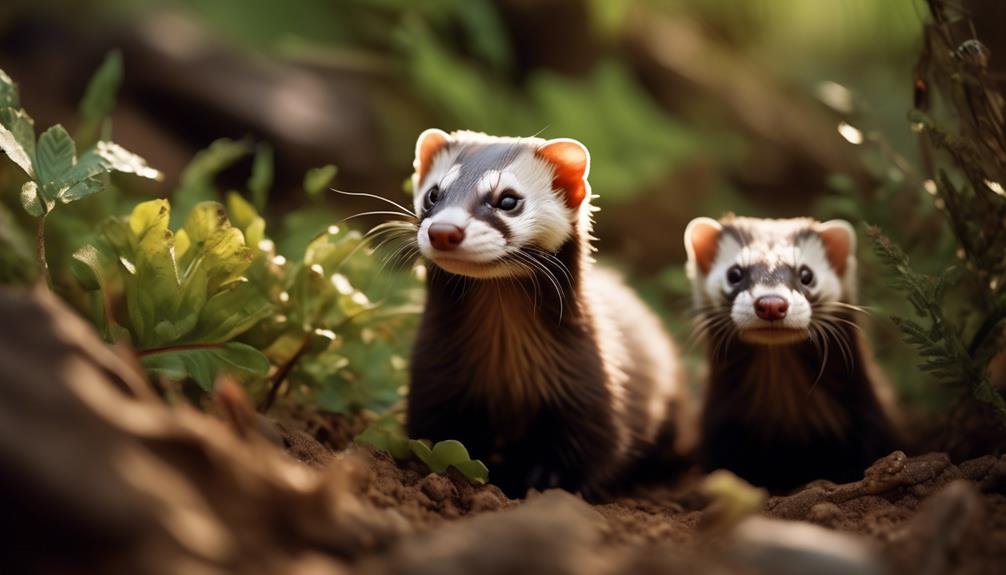
After exploring the fascinating physical characteristics and playful behavior of sable ferrets, it is essential to delve into their natural habitat and dietary preferences.
In the wild, sable ferrets live underground in prairie dog towns. As pets, they require a large enclosure with a metal cage.
When it comes to their diet, sable ferrets are obligate carnivores. In their natural habitat, they prey on mice, rabbits, chickens, and other small birds. As domesticated ferrets, they need food specifically formulated for their nutritional needs, which includes a healthy amount of taurine. It is important to provide them with a balanced diet to ensure their overall health and well-being.
However, it should be noted that the biggest threat to pet ferrets is health issues such as cancer, viruses, parasites, adrenal gland disorders, distemper, and dental problems.
Domestic Diet and Feeding Tips
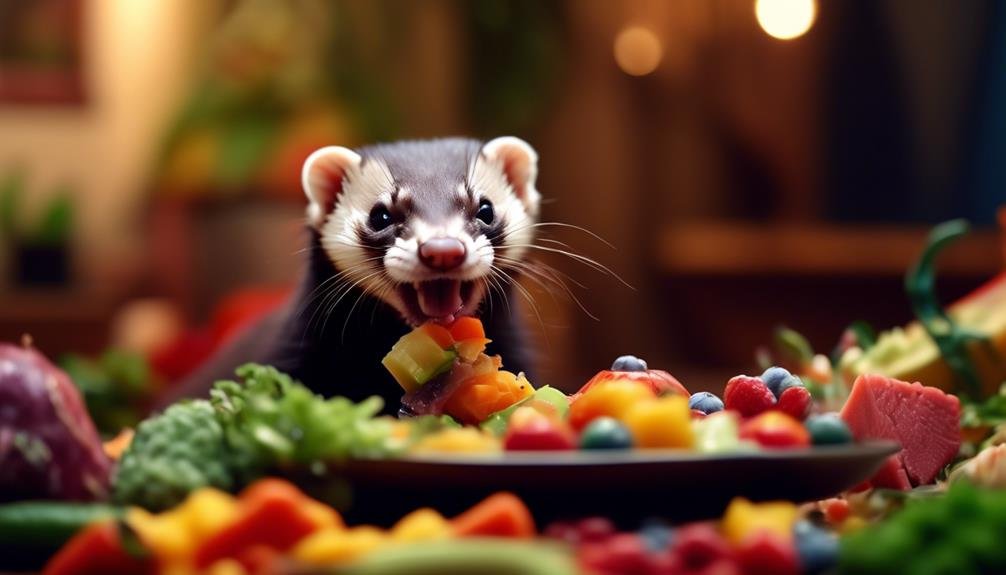
To ensure optimal health and nutrition for domestic sable ferrets, it is crucial to carefully consider their diet and implement proper feeding practices. Here are three important tips to keep in mind when feeding your sable ferret:
- Provide a high-quality, commercially prepared ferret food: Sable ferrets are obligate carnivores, meaning their diet should primarily consist of meat-based products. Look for a ferret-specific food that is high in animal protein and fat and low in carbohydrates.
- Offer fresh, raw or cooked meat: In addition to a balanced commercial diet, it is recommended to provide fresh, raw or cooked meat as a supplement. Offer small pieces of lean meats like chicken, turkey, or beef to mimic their natural diet.
- Avoid certain foods: Some foods are toxic to ferrets and should be avoided completely. These include chocolate, caffeine, onions, garlic, grapes, and raisins. Additionally, do not feed your ferret dairy products, fruits, or vegetables as they lack the necessary digestive enzymes to process these foods.
Health Concerns and Care
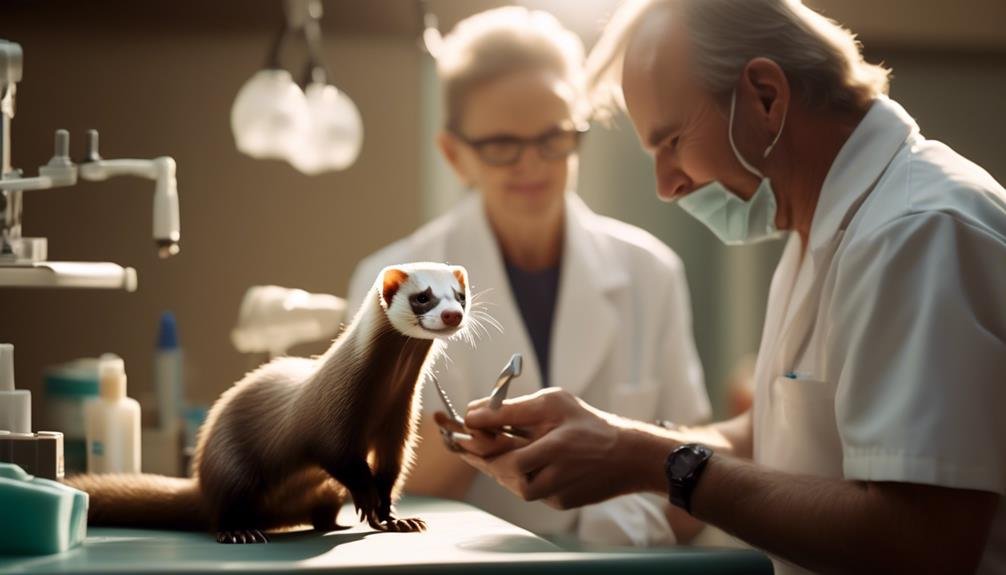
When considering the health concerns and care of sable ferrets, it is important to prioritize their well-being through proper veterinary guidance and regular check-ups. Sable ferrets are susceptible to various health issues, including cancer, viruses, parasites, adrenal gland disorders, distemper, and dental problems. To ensure their health and longevity, it is crucial to provide them with a suitable habitat, a balanced diet, and regular exercise. Additionally, ferrets should receive vaccinations and preventative treatments for parasites. Here is a table summarizing the common health concerns of sable ferrets:
| Health Concerns | Symptoms |
|---|---|
| Cancer | Lumps, weight loss, lethargy |
| Viruses | Sneezing, coughing, fever |
| Parasites | Scratching, hair loss, diarrhea |
| Adrenal gland disorders | Hair loss, swollen belly, aggression |
| Distemper | Fever, vomiting, diarrhea |
| Dental problems | Bad breath, difficulty eating |
Training and Enrichment
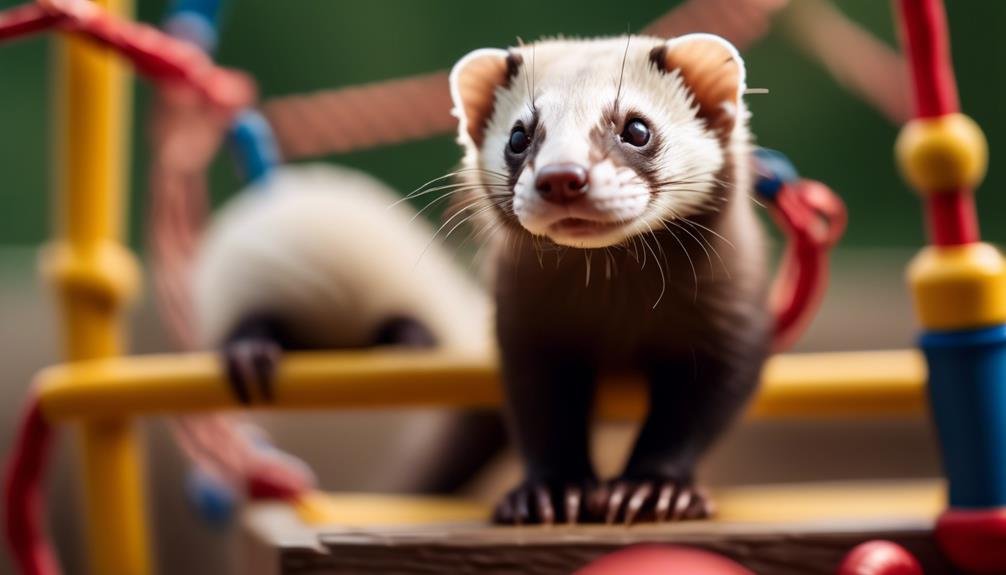
Training and enrichment are crucial for the development and well-being of sable ferrets. These intelligent and curious creatures thrive when given opportunities to learn and explore. There are three key aspects of training and enrichment for sable ferrets:
- Socialization: Interacting with humans and other animals from a young age helps sable ferrets develop proper social skills. Regular handling and supervised playdates with other ferrets can prevent aggression and promote healthy relationships.
- Mental Stimulation: Sable ferrets have active minds and need mental stimulation to prevent boredom. Providing puzzle toys, tunnels, and hiding spots can keep them mentally engaged and prevent destructive behaviors.
- Trick Training: Sable ferrets are capable of learning tricks and commands. By using positive reinforcement techniques, such as treats and praise, you can teach your ferret to perform fun tricks like rolling over or fetching. Training sessions also provide mental stimulation and strengthen the bond between you and your furry friend.
Common Sounds and Communication
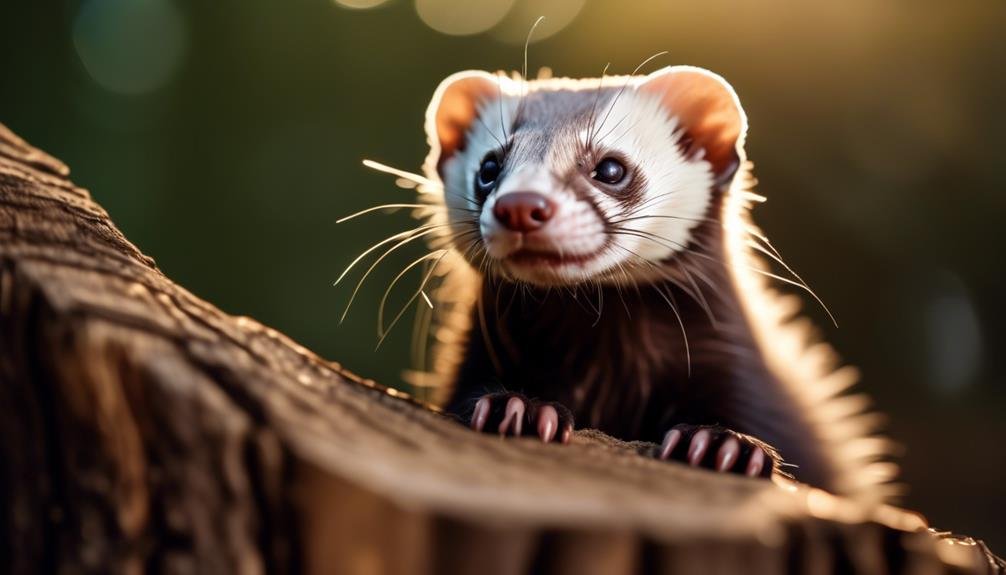
Sable ferrets utilize a variety of vocalizations and body language to communicate with each other and their human caretakers. They have a wide range of sounds, including docks, clucks, screeches, squeaks, barks, and hisses. Each sound has a specific meaning and is used to convey different messages.
For example, docks and clucks are often used to express contentment and happiness, while screeches and hisses are signs of fear or aggression. Sable ferrets also use body language to communicate, such as arching their back and puffing up their fur to appear larger when they feel threatened.
Understanding these sounds and body signals is crucial for ferret owners to establish a strong bond and effectively communicate with their furry companions.
Choosing the Right Ferret
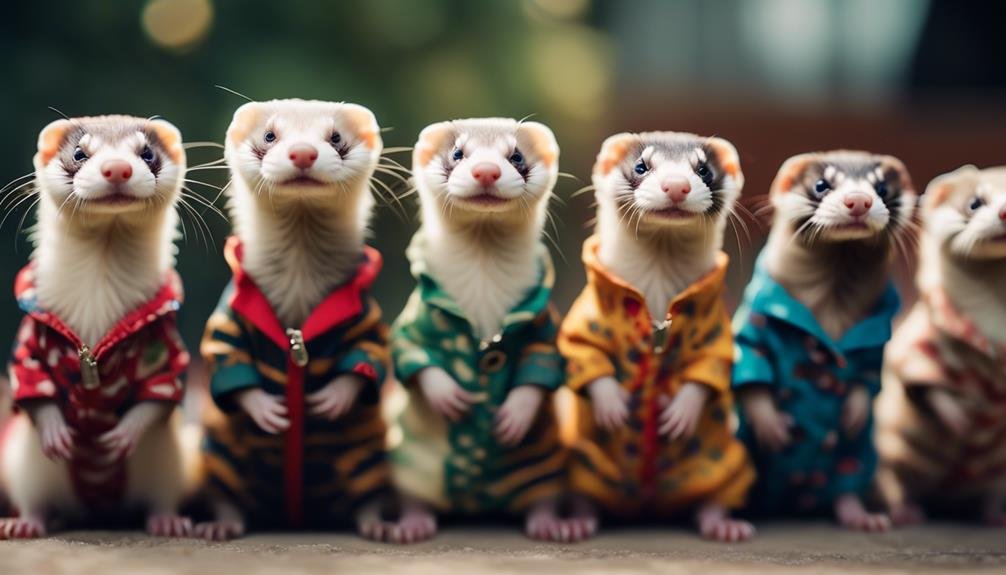
To ensure a successful and fulfilling relationship with a sable ferret, it is important to carefully consider and choose the right ferret for your individual circumstances and lifestyle. Here are three key factors to keep in mind when selecting a sable ferret:
- Age: Determine whether you want a baby ferret (kit) or an adult. Kits require more training and socialization, but they can develop a strong bond with their owners. Adult ferrets, on the other hand, may already be trained and have established personalities.
- Energy Level: Consider your activity level and how much time you can dedicate to playing and exercising with your ferret. Some ferrets are more energetic and require more mental and physical stimulation, while others are more laid-back.
- Compatibility: If you already have other pets, it is crucial to ensure that they will get along with a new ferret. Take into account their temperament and socialization needs to ensure a harmonious household.
Fun Facts and Trivia
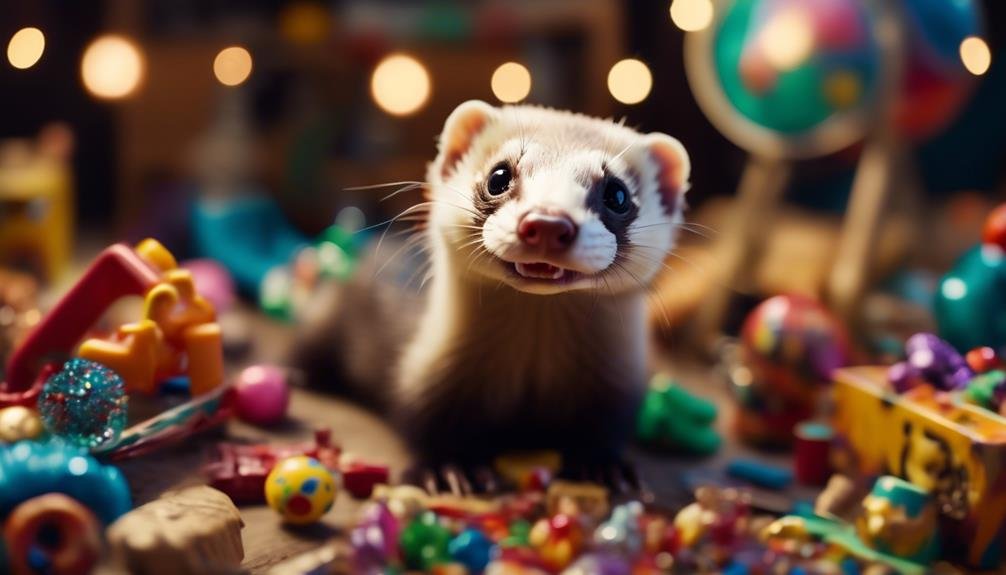
Ferrets, including sable ferrets, have a fascinating array of unique characteristics and behaviors that make them an intriguing choice for pet owners. Here are some fun facts and trivia about sable ferrets:
| Fun Facts and Trivia |
|---|
| Sable ferrets have a distinctive dark mask on their faces |
| They can sleep up to 18-20 hours a day |
| Sable ferrets can be trained to do tricks and use a litter box |
| They have a variety of sounds, including docks, clucks, screeches, squeaks, barks, and hisses |
These facts showcase the playful nature and adaptability of sable ferrets. Their unique appearance, with the dark mask, adds to their charm. Additionally, their ability to be trained and their range of vocalizations make them an entertaining pet to have. It’s important to note that while sable ferrets have these fun attributes, proper care and attention should be given to ensure their health and well-being.
Frequently Asked Questions
Can Sable Ferrets Be Trained to Do Tricks and Use a Litter Box?
Sable ferrets can indeed be trained to do tricks and use a litter box. They are known for their intelligence and can learn various behaviors through positive reinforcement. Consistent training and patience are key to successfully teaching these skills.
What Are the Common Sounds and Communication Methods of Sable Ferrets?
Sable ferrets communicate through various sounds and behaviors. They make sounds such as docks, clucks, screeches, squeaks, barks, and hisses. They also use body language, scent marking, and physical interactions to convey messages and establish social hierarchies.
What Are the Health Concerns and Care Tips for Pet Sable Ferrets?
When caring for pet sable ferrets, it is important to be aware of common health concerns such as cancer, viruses, parasites, adrenal gland disorders, distemper, and dental problems. Providing a proper diet and regular veterinary check-ups can help ensure their well-being.
How Do Sable Ferrets Behave and What Is Their Typical Sleep Pattern?
Sable ferrets are inquisitive and playful creatures, known to sleep for 18-20 hours a day. They can be trained to do tricks and use a litter box, and make a variety of sounds including docks, clucks, screeches, squeaks, barks, and hisses.
What Is the Natural Habitat and Diet of Sable Ferrets in the Wild?
The natural habitat of sable ferrets in the wild is prairie dog towns, where they live underground. They prey on mice, rabbits, chickens, and other small birds. Their diet consists of a carnivorous diet, requiring food specifically formulated for their nutritional needs.
What Makes the Sable Ferret So Special and Unique?
The Sable ferret is a rare blaze ferret with a rich and luxurious coat. Endangered due to habitat loss, it has a unique and playful nature, making it a wonderful pet. Its special coloring and charming personality make it a sought-after companion for animal lovers.
Conclusion
In conclusion, the sable ferret is a fascinating creature with a rich history and unique qualities. From their playful and inquisitive nature to their trainable abilities, they make delightful companions.
Understanding their habitat requirements, dietary needs, and potential health concerns is crucial for providing proper care. By delving into the captivating world of the sable ferret, we gain insights into how to care for these remarkable creatures and appreciate their sizzling secrets.



